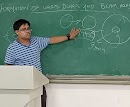Quantum Harmonic Oscillator Part-2: Schrödinger’s Equation with Dimensionless Terms!!!
This article is part 2 of the article series I wrote about Quantum Harmonic Oscillator. If you haven’t read the part-1 of it where I introduced the topic, then it will be for you to challenging understand this article. So, I highly suggest you read that article first and then proceed in this article.
Now, let’s get started with this article….
Almost any incarnation of Schrödinger’s equation can be made dimensionless
by finding two combinations. The first combination includes the mass of the particle
(m), ħ (reduced Planck’s
constant which is h/2π) and a constant with a dimension of reciprocal length (let’s
say it as α). Another
combination includes the mass of the particle (m), ħ and a constant with a dimension of reciprocal
energy (let’s say it as ε). Then we define dimensionless variable,
ξ = αx (1)
λ = εE (2)
x and E are in Schrödinger’s Equation are the cast items of ξ and λ.
The result is a dimensionless differential equation that is free of
constants, consequently easier to manipulate than the original version. This has
been done because, in general, dimensionless formulations are amenable to computation
as we don’t have to deal with units and quantities which are exceptionally large
or small in magnitude. Once we get the solution of the dimensionless
differential equation, they can be put back in terms of original variables by
simple substitutions.
As we have discussed in my Part-1 that harmonic oscillator potential has
only one constant k so we begin by finding a combination of m, ħ and k that has units of reciprocal meters or
inverse meters (finding for α). We will use simple dimension analysis to find the powers a,
b and c for m (unit - kg), k (unit -kg/sec^2) and ħ (unit - joule/sec
or kg meter^2/sec) respectively.
α ≡ (m^a) (k^b) (ħ^c)
meter^–1 ≡ [(kg)^a] [(kg / sec^2)^b] [(kg meter^2
/ sec)^c]
meter^–1 ≡ [kg^(a+b+c)] [meter^2c] [sec^–(2b +c)] (3)
so, when we compare LHS and RHS of equation 3, we get,
2c = –1
So, c = –1/2 (4)
Also,
2b + c = 0
(5)
and, a + b + c = 0 (6)
So, after solving equation 5 and 6 and putting the value of c from
equation 4, we get,
a = 1/4
b = 1/4
So,
α = (m^a) (k^b) (ħ^c) = (m^1/4) (k^1/4) (ħ ^–1/2)
α = (m k / ħ ^2)^1/4 (7)
similarly, we will also find for reciprocal energy or inverse joules,
ε ≡ (m^a) (k^b) (ħ ^c)
joule ^–1 ≡ [(kg)^a] [(kg / sec^2)^b]
[(kg meter^2 / sec)^c]
[(sec^2)/(kg
meter^2)] ≡ [kg^(a+b+c)] [meter^2c] [sec^–(2b +c)] (8)
So, by comparing LHS and RHS of equation
8, we get,
a = 1/2
b = –1/2
c = –1
So,
ε = (m^a) (k^b) (ħ ^c) = (m^1/2) (k^–1/2) (ħ ^–1)
ε = (1 / ħ)√(m / k)
ε = 1 / ħω (9)
where, ω = √ (k / m) is the angular frequency of a
classical mass/spring system.
For algebraic convenience, ε can be defined with
an additional dimensionless factor of 2.
So, equation 9 changes to,
ε = 2 / ħω (10)
After this we define dimensionless variables, as we did in equation 1
and 2.
Then, substituting them into Schrödinger’s equation for the harmonic
oscillator, and remember to make the substitution in the derivative as well, after
which I get,
d^2 / dx^2 = α^2 (d^2 / d ξ^2)
Thus, reducing Schrödinger’s equation,
d^2 ψ / d ξ^2
+ ( λ – ξ^2) ψ
= 0 (11)
This is a very cleaner equation as compared to the original one. We
will use equation 11 in our Part 3 of QHO. In part 3, we will dig into the
concept of Asymptotic Solution of QHO. Once it's uploaded, the link will be
uploaded here.
Thanks for Reading!!!
-Ratnadeep Das Choudhury












0 Comments